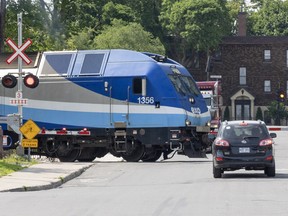The dire effects on traffic, the climate and a possible “transit death spiral” wouldn’t justify the ARTM’s negligible savings.

There’s a meme going around the internet these days that would likely get a knowing guffaw out of many Montrealers.
“Montreal is only two hours from … Montreal,” says the caption, superimposed over a photo of a traffic jam.
It’s not far from truth in this city and the wider region. With all the traffic, collisions, stalls, construction, detours, lane reductions and weekend closures, rush-hour gridlock often feels like a 24/7 phenomenon. But it’s also possible we ain’t seen nothing yet.
Alas, it looks like Quebec is going to rob Peter to pay Paul.
To be clear, the ARTM isn’t floating the idea of axing entire commuter train lines because it will improve service. On the contrary, this is a desperate bid to deal with years of chronic transit underfunding in Quebec. The ARTM is facing significant and escalating deficits that could amount to more than $2 billion over five years. So far, the Quebec government has stubbornly refused to completely fill the hole.
In 2025, the ARTM’s funding gap is projected to reach $560 million, but the Quebec government has so far only agreed to cover $200 million. The shortfall is set to reach $700 million by 2028.
Buses simply can’t match the capacity of the trains. Some commuters would have no choice but to drive. And if they’d just end up sitting in traffic on a bus, what’s the point anyhow?
So cancelling the trains will put more cars on the road, creating more traffic, more emissions — and more misery for motorists stuck in gridlock.
That’s not to say Exo train service is currently optimal. Most departures are limited to early mornings and returns to evenings, with gaps in the middle of the day. In some cases, there is no weekend service.
One of the complaints of the North Shore mayors is that the Mascouche route is too circuitous and time-consuming, especially after the trains were barred from the Mount Royal Tunnel when the REM took over the tracks.
The schedule doesn’t work for everyone. But for those who rely on the train to get to work or school, it is vital.
Montrealers can only dream of the kind of train service other cities have. In New York City, there are hourly departures between Grand Central and upstate communities — even on Sunday. And the trains are often packed. The stunning views along the Hudson River on the Poughkeepsie line are an attraction for day-trippers from Manhattan. And the Greater Toronto area’s GO service attempts to lure tourists aboard its commuter trains on weekends to head to Niagara Falls and the surrounding wine region.
Perhaps maximizing use of the train service we do have could be one way for the ARTM to turn things around. Since the pandemic, traffic for the three lines on the chopping block has rebounded only 20 per cent for Mascouche, 35 per cent for Mont-St-Hilaire and 53 per cent for Candiac. Could Montrealers looking to pick apples or go to the spa in Mont-St-Hilaire be a fresh revenue stream to tap?
Montrealers need more transit options — not fewer.
Confronting the climate emergency also demands the expansion of transit rather than a reversal. In Quebec, over 40 per cent of emissions come from transportation, most of it tailpipe pollution. This is not only the largest, but the fastest-growing source of Quebec’s greenhouse gases. And electrification alone will not bring them down. Scuttling three train lines would be a colossal error.
The Legault government hasn’t seemed moved by the economic, environmental or human toll of underfunding public transit. But perhaps the political fallout will get its attention.
Perhaps in this regard, there’s some method to the ARTM’s madness.